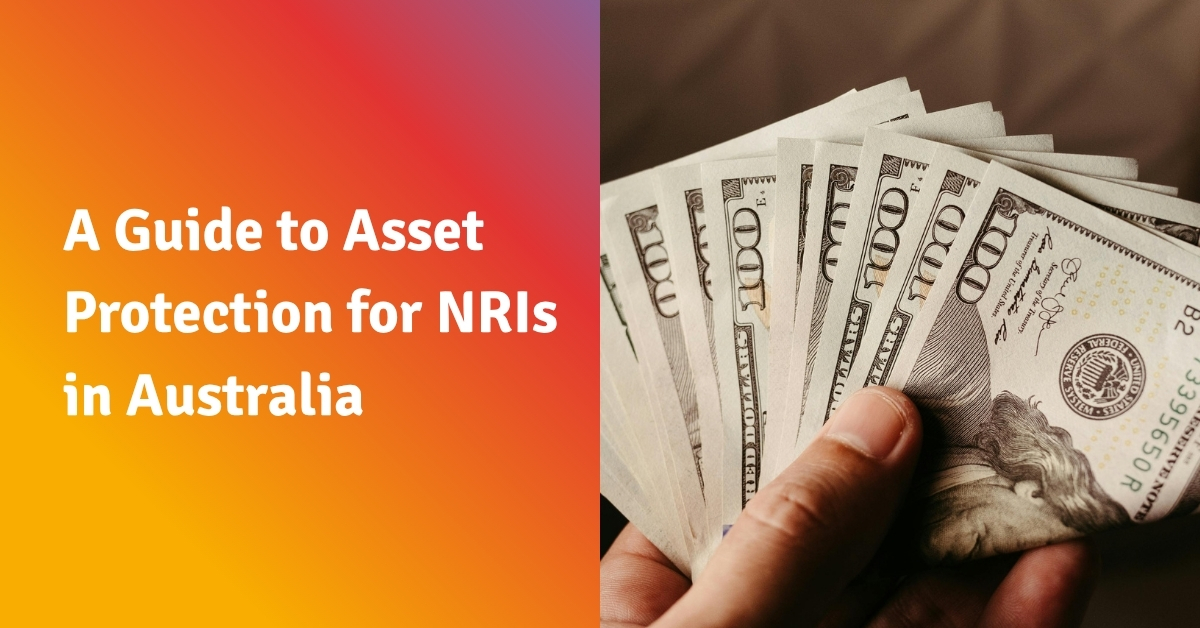A Guide to Asset Protection for NRIs in Australia

Asset protection is a critical component of financial planning for Non-Resident Indians living in Australia. With assets potentially spread across two countries, each with different legal systems, tax regimes, and regulatory frameworks, protecting your wealth requires careful planning and strategic implementation. This comprehensive guide explores the key strategies and considerations for safeguarding your assets while maximizing growth opportunities.
Understanding Asset Protection Fundamentals
Asset protection involves legally structuring your wealth to minimize risks from potential creditors, lawsuits, regulatory changes, and other unforeseen circumstances. For NRIs in Australia, this becomes particularly complex due to the need to consider both Australian and Indian legal systems, each with distinct approaches to asset protection and wealth preservation.
The primary goal is not to hide assets or avoid legitimate obligations, but rather to structure your wealth in a way that provides legal protection while maintaining accessibility and growth potential. This requires understanding the interplay between different jurisdictions and how various structures can work together to provide comprehensive protection.
Australian Asset Protection Structures
Australia offers several sophisticated asset protection structures that can be particularly beneficial for NRIs. Discretionary trusts, also known as family trusts, are among the most popular structures for asset protection and tax planning. These trusts provide flexibility in distributing income and capital while potentially protecting assets from individual creditors.
Self-Managed Super Funds (SMSFs) offer another layer of asset protection, as superannuation assets are generally protected from creditors under Australian law. For NRIs, SMSFs can be particularly attractive as they offer significant tax advantages and investment flexibility while providing strong asset protection features.
Corporate structures can also provide asset protection benefits, particularly for business assets or investment properties. By holding assets through companies, you can potentially limit personal liability and create additional layers of protection.
Cross-Border Asset Protection Considerations
The complexity of cross-border asset protection cannot be overstated. Indian assets may be subject to different creditor protection rules than Australian assets, creating both opportunities and challenges. Understanding how Indian courts view foreign judgments and vice versa is crucial for developing an effective protection strategy.
Consider the implications of the Double Taxation Avoidance Agreement (DTAA) between India and Australia, which affects not only taxation but also how assets are viewed from a legal perspective. This agreement can provide both protection and exposure, depending on how your assets are structured.
Foreign exchange regulations in both countries can impact asset protection strategies. Australia’s foreign investment rules and India’s FEMA (Foreign Exchange Management Act) regulations must be carefully considered when structuring cross-border asset protection plans.
Insurance as Asset Protection
Comprehensive insurance coverage forms a fundamental component of asset protection strategy. In Australia, consider professional indemnity insurance, public liability insurance, and directors and officers insurance if you’re involved in business activities. These insurance policies can provide the first line of defense against potential claims.
Life insurance can serve dual purposes of providing for dependents and protecting assets. Insurance proceeds are generally protected from creditors and can be structured to provide tax-efficient wealth transfer. Consider both term and whole life insurance options based on your specific circumstances and goals.
International insurance coverage becomes important when you have assets in multiple countries. Ensure your insurance coverage extends appropriately across jurisdictions and doesn’t leave gaps in protection.
Estate Planning and Succession Protection
Effective estate planning is essential for long-term asset protection. This involves creating wills that are valid in both Australia and India, understanding inheritance laws in both countries, and considering the impact of different succession regimes on your asset protection strategy.
Consider establishing international estate planning structures that can provide protection while ensuring smooth wealth transfer to beneficiaries. This might include international trusts, foundations, or other structures that can bridge different legal systems.
Plan for potential changes in tax laws or regulations that might impact your estate planning strategy. Having flexible structures that can adapt to changing circumstances is crucial for long-term asset protection.
Property and Real Estate Protection
Real estate often represents a significant portion of NRI wealth and requires specific protection strategies. In Australia, consider how property ownership structure affects asset protection. Holding property through trusts or corporate structures can provide protection while potentially offering tax advantages.
For Indian real estate, understand the limitations and benefits of different ownership structures. Joint ownership, trust structures, or corporate ownership each have different implications for asset protection and should be chosen based on your specific circumstances.
Consider the impact of property investment loans and how they might affect your overall asset protection strategy. Negative gearing strategies in Australia can provide tax benefits but might also create additional risks that need to be managed.
Business Asset Protection
If you’re involved in business activities, protecting business assets becomes crucial. This might involve separating operating assets from valuable intellectual property, using holding company structures, or implementing robust corporate governance practices.
Consider the implications of personal guarantees on business loans and how they might affect your personal asset protection strategy. Sometimes, providing limited guarantees or using alternative security arrangements can provide the necessary business flexibility while maintaining asset protection.
Professional licensing and regulatory compliance can also impact asset protection. Ensure that your business structures comply with all relevant Australian and Indian regulations while providing appropriate protection benefits.
Investment Structure Optimization
The way you structure your investments can significantly impact asset protection outcomes. Diversifying across different asset classes, jurisdictions, and structures can provide both growth opportunities and protection benefits.
Consider using international investment structures that can provide asset protection while maintaining growth potential. This might include offshore investment funds, international insurance bonds, or other structures that can legally separate assets from potential creditors.
Balance the benefits of asset protection with the need for liquidity and accessibility. Over-complicating structures can sometimes create more problems than they solve, particularly if you need quick access to funds for legitimate purposes.
Regulatory Compliance and Reporting
Maintaining compliance with all relevant regulations is essential for effective asset protection. This includes Australian taxation obligations, Indian regulatory requirements, and any international reporting obligations that might apply to your structures.
Keep detailed records of all asset protection structures and their purposes. This documentation can be crucial if structures are ever challenged or if you need to demonstrate legitimate asset protection purposes.
Consider the ongoing costs and complexity of maintaining asset protection structures. While protection is important, the structures should be cost-effective and manageable over the long term.
Monitoring and Adaptation
Asset protection is not a one-time exercise but requires ongoing monitoring and adaptation. Regularly review your structures to ensure they continue to meet your needs and provide appropriate protection as circumstances change.
Stay informed about changes in laws and regulations that might affect your asset protection strategy. This includes changes in both Australian and Indian laws, as well as international agreements that might impact cross-border structures.
Consider working with professional advisors who specialize in cross-border asset protection and can help you navigate the complex regulatory landscape while maintaining effective protection strategies.
Risk Assessment and Mitigation
Conduct regular risk assessments to identify potential threats to your assets. This might include professional liability risks, business risks, personal risks, or regulatory risks. Understanding these risks is the first step in developing appropriate protection strategies.
Develop contingency plans for different risk scenarios. This might include having alternative structures ready to implement, maintaining emergency funds in protected accounts, or having legal strategies prepared for potential challenges.
Remember that asset protection is about managing risk, not eliminating it entirely. Focus on protecting against the most likely and most damaging risks while maintaining reasonable access to your assets for legitimate purposes.
Conclusion
Given the complexity of cross-border asset protection, working with professionals who understand both Australian and Indian legal and financial systems is essential. Engage with experts such as lawyers, accountants, and financial planners who specialize in international planning and can develop integrated strategies that align with your unique situation as an NRI.
It’s equally important to have an NRI tax advisor in India who can coordinate with your Australian advisors to ensure your financial structures are compliant and tax-efficient in both jurisdictions. This collaborative approach helps safeguard your assets while minimizing tax liabilities across borders.
Regular reviews of your asset protection plan are crucial. As laws evolve and personal circumstances change, your strategy must adapt to stay effective and compliant. With proper planning, trusted advisors in both countries, and a proactive mindset, NRIs in Australia can protect their wealth while unlocking long-term growth opportunities.
FAQs
- Why is asset protection important for NRIs in Australia?
Ans- Because NRIs have assets in both India and Australia, protecting them from legal, tax, and financial risks across borders is essential.
- What is the best structure for asset protection in Australia?
Ans- Discretionary (family) trusts and Self-Managed Super Funds (SMSFs) are commonly used for asset protection and tax benefits.
- Are SMSFs safe from creditors in Australia?
Ans- Yes, SMSF assets are generally protected from creditors under Australian law, making them a strong asset protection tool.
- Can Indian laws affect my assets in Australia?
Ans- Directly, no. But for cross-border planning, understanding both legal systems helps prevent conflicts and ensure effective protection.
- What role does insurance play in asset protection?
Ans- Insurance is the first line of defense—covering liabilities and ensuring wealth isn’t eroded by lawsuits or unexpected events.
- Do I need separate wills for India and Australia?
Yes, having valid wills in both countries ensures smoother estate distribution and avoids legal disputes.
- Can I protect Indian real estate through an Australian trust?
Ans- Not directly. You need to explore Indian trust or company structures that align with FEMA regulations for asset protection.
- What is the DTAA and how does it relate to asset protection?
Ans- The DTAA between India and Australia helps avoid double taxation and can influence how assets are treated legally and fiscally.
- Should I involve professionals in my asset protection planning?
Ans- Absolutely. Cross-border asset protection is complex and requires coordination between legal and financial experts in both countries.
- How often should I review my asset protection strategy?
Ans- At least annually, or whenever there is a major life event or change in law, tax rules, or asset ownership.
Disclaimer: The information provided here is for educational and informational purposes only and should not be construed as financial, legal, or tax advice. Consult with a qualified professional before making any investment decisions. We do not accept any liability for errors or omissions in this information nor any direct, indirect, or consequential losses arising from its use.




